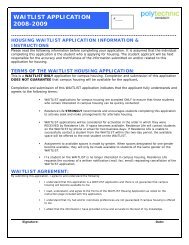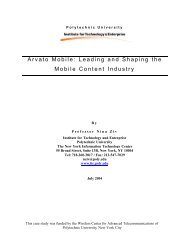POLYTECHNIC UNIVERSITY 2005-2007
POLYTECHNIC UNIVERSITY 2005-2007
POLYTECHNIC UNIVERSITY 2005-2007
Create successful ePaper yourself
Turn your PDF publications into a flip-book with our unique Google optimized e-Paper software.
BIOMEDICAL ENGINEERING PROGRAM<br />
Academic Director: Richard A. Gross<br />
THE MASTER OF SCIENCE IN<br />
BIOMEDICAL ENGINEERING<br />
GOALS AND OBJECTIVES<br />
The primary goal of the MS in<br />
Biomedical Engineering Program is to<br />
provide students with an in-depth,<br />
advanced education that gives them the<br />
tools needed to perform fundamental and<br />
applied research in biomedical engineering.<br />
Alternatively, students gain the requisite<br />
technical knowledge that they may<br />
wish to apply to management, marketing,<br />
sales and other entrepreneurial activities<br />
related to biomedical engineering.<br />
Specific objectives include:<br />
• To enroll students who have a BS or a<br />
more advanced degree in any engineering<br />
discipline, mathematics or in<br />
any of the natural sciences<br />
• To provide students with a cuttingedge<br />
program that integrates engineering,<br />
biological and medical sciences.<br />
Students will acquire the skills to participate<br />
in technological innovations<br />
that provide people with longer,<br />
healthier and more productive lives<br />
• To merge the leadership and talents<br />
found at Polytechnic in chemistry,<br />
engineering and computer science<br />
with the expertise in medical sciences<br />
at SUNY Downstate Medical Center<br />
• To give students an opportunity to<br />
focus on topics that include biomedical<br />
instrumentation, biomaterials and<br />
therapeutic systems, bioinformatics<br />
and biomolecular engineering<br />
• To give students the option of doing<br />
research in the laboratories at<br />
Polytechnic and/or SUNY Downstate<br />
Medical Center. Students may also<br />
substitute research credits with course<br />
electives<br />
In the years ahead, health and human productivity<br />
can be vastly improved through<br />
major advances in medicine. These<br />
advances will happen through the successful,<br />
seamless integration of biology<br />
and modern engineering. Scientists anticipate<br />
future breakthroughs ranging from<br />
the design of drugs customized to an individual’s<br />
genome to the perfection of artificial<br />
implantable organs. Aggressive and<br />
intelligent integration of engineering and<br />
the biological and medical sciences will<br />
hasten the realization of these and other<br />
innovations, leading to longer, healthier<br />
and more productive lives. Scientists can<br />
now visualize structures inside the body<br />
with a level of clarity thought impossible<br />
only a decade ago. With the improved<br />
diagnosis that comes from these advances<br />
and those that will follow, further discoveries<br />
in the area of treatment will be<br />
added.<br />
Today, miniature devices can be<br />
manipulated through endoscopes, making<br />
it possible to perform surgical procedures<br />
with minimal invasion and thus minimal<br />
trauma to the patient. In the future, the<br />
microfabrication of biomedical devices at<br />
Polytechnic and elsewhere will further<br />
enable surgery and increase the functionality<br />
of the physically impaired in applications<br />
ranging from congenital defects to<br />
improving the function of major organs,<br />
such as the heart, kidneys and liver. Other<br />
areas show similar promise—breakthroughs<br />
in human tissue research point to<br />
the possibilities of replacing damaged or<br />
diseased bone, cartilage, and other tissues<br />
with newly engineered materials.<br />
Bioresorbable materials will substitute for<br />
permanent implants allowing recovery of<br />
tissues with subsequent clearance from<br />
the system of the degraded implant material.<br />
New imaging systems are emerging<br />
that provide new information and monitoring<br />
possibilities. Wireless technology<br />
will integrate into medical devices and<br />
home-care systems. There is little doubt<br />
that these and other extraordinary developments<br />
will dramatically impact lives<br />
over the next few decades.<br />
By merging the leadership and talents<br />
found at Polytechnic in chemistry, engineering<br />
and computer science with the<br />
expertise in biomedical sciences at the<br />
SUNY Downstate Medical Center, the<br />
University is well positioned to offer a<br />
cutting-edge program with a broad range<br />
of opportunities to its students. The partnership<br />
between Polytechnic and SUNY<br />
Downstate is dedicated to this new mode<br />
of biomedical education, and to the development<br />
of students with both practical<br />
and fundamental knowledge. Students<br />
will have the opportunity to move freely<br />
between the University and SUNY<br />
Downstate, taking advantage of both<br />
facilities, their faculty and associated<br />
research programs. In some cases, courses<br />
will be team-taught by faculty from both<br />
locations. The outcome is the creation of<br />
courses of superior quality. Polytechnic’s<br />
goal is to provide students with the best in<br />
classroom and laboratory education to<br />
give them the skills to succeed in the wide<br />
range of opportunities that will be open to<br />
them upon graduation.<br />
A Perfect Formula for a Successful<br />
Biomedical Engineering Program<br />
The recent strategic alliance between<br />
SUNY Downstate Medical Center and<br />
Polytechnic University created the framework<br />
that has resulted in Downstate’s<br />
important contribution to Polytechnic’s<br />
Masters of Science in Biomedical<br />
Engineering Program. The two institutions<br />
have coextensive research interests<br />
with complementary technological<br />
expertise. Noteworthy common areas of<br />
scientific investigation include:<br />
• Telemetry<br />
• Neurorobotics<br />
• Optical imaging<br />
• Bioresorbable Biomedical Materials<br />
• Drug Delivery Systems<br />
• Tissue Engineering<br />
• Microchip Sensors<br />
• Biosensors<br />
FULL AND PART-TIME STUDENTS<br />
Students entering this master’s program<br />
may wish to complete the degree rapidly<br />
by taking a full course load, or proceed at<br />
a slower pace if they are working professionals<br />
with other full or part-time commitments.<br />
The curriculum structure and<br />
class schedule for this program were constructed<br />
to accommodate both part-time<br />
and full-time students. Thus, most of the<br />
3-credit courses offered are given as twoand-a-half<br />
hour lectures one evening per<br />
week during the semester. Evening<br />
research opportunities are also available.<br />
100




